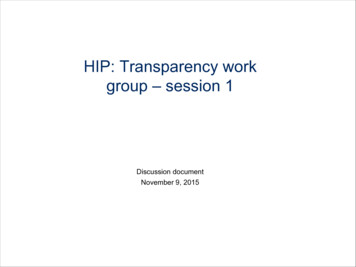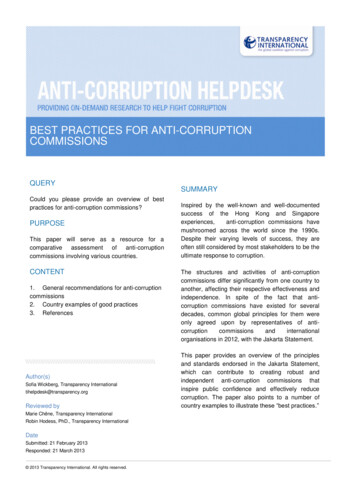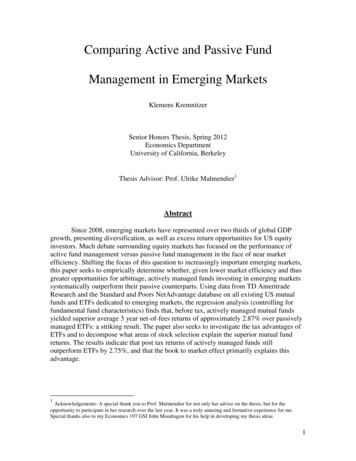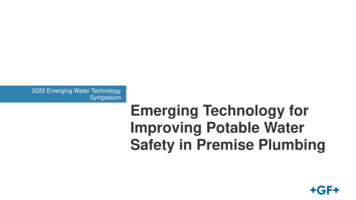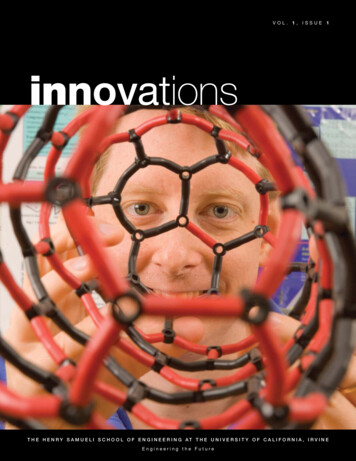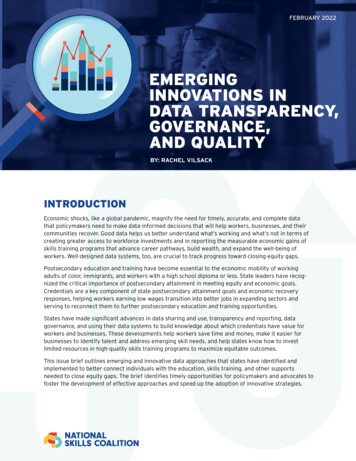
Transcription
FEBRUARY 2022EMERGINGINNOVATIONS INDATA TRANSPARENCY,GOVERNANCE,AND QUALITYBY: RACHEL VILSACKINTRODUCTIONEconomic shocks, like a global pandemic, magnify the need for timely, accurate, and complete datathat policymakers need to make data-informed decisions that will help workers, businesses, and theircommunities recover. Good data helps us better understand what’s working and what’s not in terms ofcreating greater access to workforce investments and in reporting the measurable economic gains ofskills training programs that advance career pathways, build wealth, and expand the well-being ofworkers. Well-designed data systems, too, are crucial to track progress toward closing equity gaps.Postsecondary education and training have become essential to the economic mobility of workingadults of color, immigrants, and workers with a high school diploma or less. State leaders have recognized the critical importance of postsecondary attainment in meeting equity and economic goals.Credentials are a key component of state postsecondary attainment goals and economic recoveryresponses, helping workers earning low wages transition into better jobs in expanding sectors andserving to reconnect them to further postsecondary education and training opportunities.States have made significant advances in data sharing and use, transparency and reporting, datagovernance, and using their data systems to build knowledge about which credentials have value forworkers and businesses. These developments help workers save time and money, make it easier forbusinesses to identify talent and address emerging skill needs, and help states know how to investlimited resources in high-quality skills training programs to maximize equitable outcomes.This issue brief outlines emerging and innovative data approaches that states have identified andimplemented to better connect individuals with the education, skills training, and other supportsneeded to close equity gaps. The brief identifies timely opportunities for policymakers and advocates tofoster the development of effective approaches and speed up the adoption of innovative strategies.
INNOVATION IN DATATRANSPARENCY:CONNECTING LEARNERS TOHIGH-QUALITY TRAININGBACKGROUND: The Workforce Innovation andOpportunity Act (WIOA) provides the primary fundingand policy guidance for our nation’s public workforcesystem, designed to help people, including youth andthose with significant barriers to employment (e.g.formerly incarcerated adults), secure high-quality jobsand careers, and to help employers hire and retain skilledworkers. WIOA established guidelines for states to set upa process for how education and training providers andrelated credentials would qualify to receive WIOA fundsto train eligible adults and youth.STATES SHOULD ESTABLISHROBUST QUALITY CRITERIAFOR ELIGIBLE TRAININGPROVIDERS AND REQUIREDATA DISAGGREGATIONOF EMPLOYMENT ANDWAGE OUTCOMES FORPARTICIPANTS OF TRAININGPROGRAMS BY RACE ANDETHNICITY TO ENSURETHAT PARTICIPANTS OFCOLOR ARE BEING SERVEDEQUITABLY ACROSS ANDWITHIN ELIGIBLE TRAININGPROGRAMS.Eligible Training Provider (ETP) lists serve as a resourcethat can help individuals make strong educationalchoices to advance their careers in alignment with stateor regional economic needs and support equitableaccess and transparency to the training and educationopportunities available for participants in WIOA Title Iprograms. States align ETP eligibility requirements withtraining programs that result in credentials aligned toin-demand industry sectors and occupations. States havediscretion in how training providers and their programsare eligible to join and remain on their ETP list, includinghow they measure the quality of the program or trainingservices. Most state and local boards set minimumperformance measurement thresholds, such as completion rates, employment rates, and median earnings.There are many working adults who want to enroll inpostsecondary education and training to develop additional skills to advance their careers or reskill withintheir current careers. But, to succeed, they need to knowwhat opportunities will help them achieve their employment goals. WIOA requires that states collect data fromETPs on the performance outcomes of their studentsby program of study and make that information easilyavailable to individuals interested in training.EMERGING INNOVATIONS IN DATA TRANSPARENCY, GOVERNANCE, AND QUALITY 2
SPOTLIGHT:NEW JERSEYNew Jersey has reimagined its ETP approval process to bolster quality assurance and transparency to inform consumer choice. The New Jersey Department of Labor and WorkforceDevelopment, along with the Heldrich Center for Workforce Development at Rutgers University,developed a model to assess which training providers and their programs are achieving equitable outcomes.The model analyzes student-level data from ETPs and their programs through five dimensions:Labor market demand – Are programs associated with in-demand occupations?Employment and wage outcomes – What percent of students are employed, and how havetheir median earnings changed after training? How do these earnings compare to living wagesin the region and state?Education outcomes – What is the program completion rate?Financial impact – What is the return on investment in first-year earnings gains after a student completes the program? How do program costs compare to median earnings in occupation(s) that students can expect after the training program?Equity – How do the measures (above) differ for students by race, ethnicity, gender, disabilitystatus, and former justice involvement?The New Jersey Department of Labor and Workforce Development worked with the state’sCredential Review Board — a statutory body created for the purpose of directing the technicalcredentialing process for the workforce investment system — to adopt the quality assuranceframework and model.Starting July 1, 2022, ETPs in New Jersey are required to begin collecting new data that willmeasure program quality along the multiple dimensions. Programs scoring in the top 75 percentile will be considered “passing;” those in the 11th to 25th percentile will be encouraged toreview the reasons for their poor performance; and those in the bottom 10 percent will be put onprobation. Programs in probation will be required to develop a corrective action plan and giventwo years to improve their performance.New Jersey intentionally incorporated equity in their quality assurance framework to makesure there was no unintended consequences of incentivizing ETPs to only serve the “easiest toserve” or to avoid serving workers experiencing significant barriers in the labor market. Thisframework will ensure accountability and consumer protection. And through an updated publicinformation tool that will be released in 2022, those seeking education and training programswill find information on which credentials are worth their investment and participation, andwhich will be less helpful in their careers.EMERGING INNOVATIONS IN DATA TRANSPARENCY, GOVERNANCE, AND QUALITY 3
INNOVATION IN DATAGOVERNANCE & USE:SIMPLIFYING REPORTINGFOR TRAINING PROVIDERSBACKGROUND: In addition to setting performancethresholds that ETPs must meet to receive WIOA funds totrain eligible adults and youth (as previously discussed),WIOA also requires states to collect and report outcomeswith respect to all individuals served by each program ofstudy on the state’s ETP list. These data are importantfor states to monitor program performance of ETPs. Dataon employment and wage outcomes also provide value toWIOA participants who want to learn if the outcomes ofprogram alumni match their employment and earningsgoals.STATES SHOULDLEVERAGE EXISTINGDATA INFRASTRUCTURESTO REDUCE REPORTINGBURDENS ON TRAININGPROVIDERS, STREAMLINEDATA COLLECTIONPROCESSES, AND EXPANDUPON THE PARTNERSHIPSBETWEEN TRAININGPROVIDERS AND THEPUBLIC WORKFORCESYSTEM.Training providers may face barriers with reportingoutcomes of all students in programs of study, especiallycommunity-based organizations and training providersthat serve learners in obtaining occupation-specificcredentials (e.g., nursing assistants or truck drivers) innon-traditional academic settings. Specifically, theserequirements could place an undue burden on licensededucational institutions offering non-degree credentials(e.g., career schools) who want to serve WIOA participants. Minnesota identified several common barriers forthese training providers reporting quality data: thosethat currently don’t collect the data, have no experiencecollecting student-level personally identifiable information, or don’t have systems in place to support the datacollection required to be designated an ETP. For otherpostsecondary institutions who do collect the necessarydata and report student-level information to a state highereducation agency, the requirement to report to anotherstate agency is duplicative. In either case, their reportingbarriers can limit the breadth of skills training opportunities available to individuals.Collaborations and partnerships between higher education institutions, workforce state agencies, and trainingproviders can mitigate the data reporting and collectionburdens that training providers face and help better servelearners who are using federal workforce training dollarsto upskill and reskill to obtain a better job. These effortsalso support the overall goals of WIOA to reduce theeducational and employment disparities based on race,ethnicity, and gender, while also providing high-qualityskill training options to individuals that will meet industrydemands for a skilled workforce.EMERGING INNOVATIONS IN DATA TRANSPARENCY, GOVERNANCE, AND QUALITY 4
SPOTLIGHT:MINNESOTAThe Minnesota Department of Employment and Economic Development (DEED) and the MinnesotaOffice of Higher Education (OHE) are partnering to leverage existing data infrastructure to meetWIOA reporting requirements and minimize the reporting burden of training providers.OHE already gathers student-level enrollment and completion data from postsecondary institutions participating in state financial aid programs, many of which are ETPs. Beginning in March2022, OHE will expand this data collection to include all institutions and training providers listingprograms on Minnesota’s ETP List. The data collection is aligned to WIOA ETP reporting requirements and aligns with data currently submitted by colleges, universities, and other licensedtraining providers who are required to report student-level data to OHE.As a state educational authority, OHE is authorized by federal and state laws to receive privateeducation data for the purposes of research and reporting, which includes redisclosing data toDEED for purposes of WIOA compliance. OHE staff maintain secure methods of data transmissionand data protection required by those laws. The partnership to streamline reporting for all ETPswith one state agency also ensures alignment and consistent data governance and data sharingpractices for student-level postsecondary data. Education institutions and training providerssign a data sharing agreement with OHE that outlines how data will be used and what summarydata will be released, either to comply with federal law or to aid in the transparency of students’employment and wage outcomes. Data provided by ETPs will also be included in the StatewideLongitudinal Education Data System (SLEDS).Currently SLEDS matches student data from pre-kindergarten through completion of postsecondary education and into the workforce to gauge the effectiveness of current programs anddesign targeted improvement strategies to help students. These cross-system data linkages allowthe state to identify the most viable pathways for individuals to achieve successful outcomes ineducation and work and to inform decisions that support and improve education policy and practice. DEED leverages the SLEDS data infrastructure to fulfill its mandated ETP reporting to theU.S. Department of Labor.By simplifying a reporting process, Minnesota expects to see increased data quality of trainingprograms outcomes, including a growing repository of quality non-degree credentials. The programoutcomes of ETP will be added to the state’s existing career and education exploration website,so that prospective students and employers can see the likely employment and wage outcomes oftraining programs. Training providers will also benefit by becoming a part of the SLEDS infrastructure, which will allow them expanded access to outcomes data for their own students.EMERGING INNOVATIONS IN DATA TRANSPARENCY, GOVERNANCE, AND QUALITY 5
INNOVATION IN DATAQUALITY: MEASURINGPOSTSECONDARYCREDENTIALS OF VALUEBACKGROUND: Postsecondary education and traininghas become essential to the economic mobility of workingadults of color, immigrants, and workers with a high schooldiploma or less. State leaders have recognized the criticalimportance of postsecondary attainment in meeting equityand economic goals. Nearly every state has a postsecondaryeducation attainment goal, which sets a target for thenumber of adults within that state who hold some type ofpostsecondary credential. These goals can drive policiesthat help more individuals attain postsecondary degreesand credentials that are critical to business success and leadresidents to good jobs.Non-degree credentials, such as certificates, industrycertifications, apprenticeship certificates, and occupationallicenses are a key component of state postsecondaryattainment goals and help workers earning low wagesobtain better jobs in expanding sectors and serve to reconnect them to further postsecondary education and trainingopportunities.STATES NEED BETTERDATA ABOUT THEEMPLOYMENT ANDWAGES OUTCOMESON NON-DEGREECREDENTIALS TO TRULYDETERMINE WHATCREDENTIALS HAVEVALUE TO WORKERSAND BUSINESSES.Quality assurance is particularly important given the rolethat non-degree credentials play in providing opportunities for people of color and other underrepresented groupswho have been historically underserved by postsecondaryeducation and training. States who adopt a quality nondegree credential framework can protect against increasing equity gaps by ensuring people of color, women, thosewith disabilities, and other individuals facing opportunitygaps are not steered toward low-quality options.Data about all postsecondary programs are essential forunderstanding what credentials meet the quality criteriaset by states. While most states already have data aboutsome postsecondary programs, the data are often notcomprehensive. Many states do not have complete data onnon-credit programs of public postsecondary institutions,certificates that are awarded by proprietary institutions,or data on who obtains industry certifications issued bythird-party providers. Although states usually licenseprivate for-profit institutions, and private institutions maybe eligible for state financial aid or other state funding,relatively few states mandate that private schools sharestudent-level data in exchange for authorization or aid.EMERGING INNOVATIONS IN DATA TRANSPARENCY, GOVERNANCE, AND QUALITY 6
SPOTLIGHT:LOUISIANAIn September 2020, the Louisiana Board of Regents adopted a definition of quality non-degreecredentials to support its Master Plan for Higher Education and an ambitious attainment goalof 60 percent of working adults holding a degree or credential by 2030. A leadership teamcomprised of representatives of the Louisiana Board of Regents, Louisiana Community andTechnical College System, Louisiana Workforce Commission, Louisiana Economic Developmentand Louisiana Department of Education, along with various other agencies and organizations,developed criteria to define quality credentials for Louisiana.In addition to academic degrees, non-academic “Quality Postsecondary Credentials of Value”will count towards the state’s attainment goal if they:Provide valid, reliable and transparent evidence of the competencies mastered and be conferred by an entity recognized by business and industry and/or the State of Louisiana;Align to in-demand occupations as defined by the Louisiana Workforce Commission based onjob demand, projected job growth and earnings;Lead to an occupation with a 20 percent wage premium over a high school diploma inLouisiana;Provide evidence for employment and wage outcomes; andMeet these criteria as a stand-alone credential, independent of another credential.Through development of a credentials of value definition, the Louisiana Board of Regents (Board)recognized that data gaps exist. Namely, the outcomes of students who complete programs atproprietary and licensed institutions that lead to industry-recognized credentials or occupationallicenses operating within the state are not available for the Board to assess whether they meetthe credential of value criteria. To bridge the data gap, the Board pursued changes to the state’sAdministrative Code, which defines the licensing process for proprietary schools.The new rulemaking requires that proprietary institutions licensed by the Board, or seekingrenewal licensure, shall annually collect and report student-level data. These data include programcompletion and graduation data, type of credential earned, and student demographics, includingrace, ethnicity, gender, and Social Security Number. The Board can then match student-level datarecords to the state’s administrative wage records to produce outcomes necessary to evaluateand count Quality Postsecondary Credentials of Value towards the state’s attainment goal.EMERGING INNOVATIONS IN DATA TRANSPARENCY, GOVERNANCE, AND QUALITY 7
ENDNOTES1 For a concise overview of WIOA, please read “WIOA reauthorization is on the horizon – here’s a refresher onAmerican’s primary workforce program,” at rogram/2 WIOA Title I include three core programs: Adult, Dislocated Worker, and Youth. Other WIOA core programs include AdultEducation and Literacy (Title II), Wagner Peyser (Title III) and Vocational Rehabilitation Services (Title IV).3 In 2019, National Skills Coalition worked with 12 states to review how they were using employment, earnings, andcompetencies to set quality standards for credentials. This analysis — and feedback from research and advocacyorganizations with expertise in higher education and workforce policy, including those with a racial equity mission — led to the development of a vetted consensus definition of quality non-degree credentials that can be evaluated through data. For more information, please visit: ty-non-degree-credentials-for-states/4 Louisiana developed two categories of credentials through this process, acknowledging that individuals start their postsecondary pathways at different points: “Quality Postsecondary Credentials of Value” and “On-Ramp Credentials.” Though an on-rampcredential does not meet credential of value standards, it provides a means for individuals to get on a training pathway andbuild toward a higher-level credential. For a full definition, please visit: alue-Exec-Summary-Removed.pdfACKNOWLEDGMENTS: This report was made possible by generous support from the Bill and Melinda GatesFoundation. We thank them for their support and acknowledge that the findings, conclusions, and recommendationspresented in this report are those of National Skills Coalition alone, and do not necessarily reflect the opinions ofthe foundation.A special thanks to the states and organizations whose work is featured in this issue brief, including Lesley Hirsh(New Jersey Department of Labor and Workforce Development), Christen Pentek (Minnesota Department ofEmployment and Economic Development), Steve Rogness and Meredith Fergus (Minnesota Office of HigherEducation), Kim Kirkpatrick and Courtney Britton (Louisiana Board of Regents).ABOUT NATIONAL SKILLS COALITION: Jobs that require skills training are the backbone of our economy.National Skills Coalition (NSC) fights for a national commitment to inclusive, high-quality skills training so that morepeople have access to a better life, and more businesses see sustained growth. Since 2000, through expert analysis,and technical assistance, broad-based organizing, targeted advocacy, and cutting-edge communication, NSC haschanged hundreds of state and federal skills policies that have changed thousands of lives and grown local businesses and economies.We build networks representing businesses, workers, colleges, community organizations, public officials, and advocates. We engage these networks to craft policy proposals and mobilize them to win concrete policy change.Our networks include SkillSPAN (20 affiliate state coalitions), Business Leaders United for Workforce Partnerships(thousands of small and medium-sized business owners and 7 state affiliates), and Voices for Skills (tens of thousands of workers and grassroots skills advocates).
credentialing process for the workforce investment system — to adopt the quality assurance framework and model. Starting July 1, 2022, ETPs in New Jersey are required to begin collecting new data that will measure program quality along the multiple dimensions. Programs scoring in the top 75 percen-
